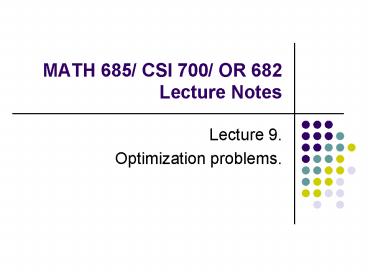MATH 685 CSI 700 OR 682 Lecture Notes - PowerPoint PPT Presentation
1 / 69
Title:
MATH 685 CSI 700 OR 682 Lecture Notes
Description:
Most optimization methods are designed to find local. minimum, which may or may ... are required, explicit formation of Hessian matrix can be avoided by using ... – PowerPoint PPT presentation
Number of Views:45
Avg rating:3.0/5.0
Title: MATH 685 CSI 700 OR 682 Lecture Notes
1
MATH 685/ CSI 700/ OR 682 Lecture Notes
- Lecture 9.
- Optimization problems.
2
Optimization
3
Optimization problems
4
Examples
5
Global vs. local optimization
6
Global optimization
- Finding, or even verifying, global minimum is
difficult, in - general
- Most optimization methods are designed to find
local - minimum, which may or may not be global
minimum - If global minimum is desired, one can try several
widely - separated starting points and see if all
produce same - result
- For some problems, such as linear programming,
global - optimization is more tractable
7
Existence of Minimum
8
Level sets
9
Uniqueness of minimum
10
First-order optimality condition
11
Second-order optimality condition
12
Constrained optimality
13
Constrained optimality
14
Constrained optimality
15
Constrained optimality
- If inequalities are present, then KKT optimality
conditions also require nonnegativity of Lagrange
multipliers corresponding to inequalities, and
complementarity condition
16
Sensitivity and conditioning
17
Unimodality
18
Golden section search
19
Golden section search
20
Golden section search
21
Example
22
Example (cont.)
23
Successive parabolic interpolation
24
Example
25
Newtons method
Newtons method for finding minimum normally has
quadratic convergence rate, but must be started
close enough to solution to converge
26
Example
27
Safeguarded methods
28
Multidimensional optimization.Direct search
methods
29
Steepest descent method
30
Steepest descent method
31
Example
32
Example (cont.)
33
Newtons method
34
Newtons method
35
Example
36
Newtons method
37
Newtons method
38
Trust region methods
39
Trust region methods
40
Quasi-Newton methods
41
Secant updating methods
42
BFGS method
43
BFGS method
44
BFGS method
45
Example
For quadratic objective function, BFGS with exact
line search finds exact solution in at most n
iterations, where n is dimension of problem
46
Conjugate gradient method
47
CG method
48
CG method example
49
Example (cont.)
50
Truncated Newton methods
- Another way to reduce work in Newton-like methods
is to solve linear system for Newton step by
iterative method - Small number of iterations may suffice to produce
step as useful as true Newton step, especially
far from overall solution, where true Newton step
may be unreliable anyway - Good choice for linear iterative solver is CG
method, which gives step intermediate between
steepest descent and Newton-like step - Since only matrix-vector products are required,
explicit formation of Hessian matrix can be
avoided by using finite difference of gradient
along given vector
51
Nonlinear Least squares
52
Nonlinear least squares
53
Gauss-Newton method
54
Example
55
Example (cont.)
56
Gauss-Newton method
57
Levenberg-Marquardt method
With suitable strategy for choosing µk, this
method can be very robust in practice, and it
forms basis for several effective software
packages
58
Equality-constrained optimization
59
Sequential quadratic programming
60
Merit function
61
Inequality-constrained optimization
62
Penalty methods
This enables use of unconstrained optimization
methods, but problem becomes ill-conditioned for
large ?, so we solve sequence of problems with
gradually increasing values of , with minimum for
each problem used as starting point for next
problem
63
Barrier methods
64
Example constrained optimization
65
Example (cont.)
66
Example (cont.)
67
Linear progamming
68
Linear programming
69
Examplelinear programming































